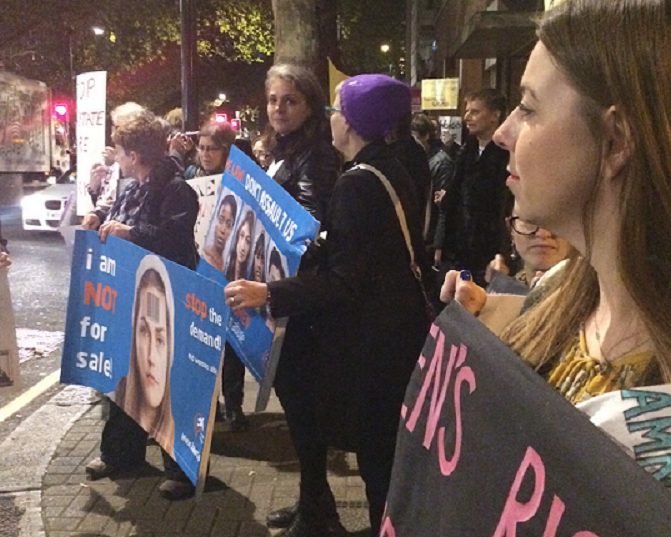
by DGR Colorado Plateau | Oct 25, 2015 | Prostitution, Protests & Symbolic Acts, Women & Radical Feminism
By Janie Davies / Feminist Current
Women protested in 50 countries on October 23, united in their opposition to Amnesty International’s recommendation for full decriminalization of the sex industry, including pimps and johns.
The campaign was organized by a coalition of individual women and women’s groups, collectively referred to as Amnesty Action.
All these women know that where full decriminalization or legalization of the sex trade take place, trafficking rises. This stands to reason because as scrutiny is removed, organized criminals are able to operate more freely.
They know that an estimated 89 per cent of women in prostitution want to get out; that about half have been raped, approximately 70 per cent have been assaulted, and that the average age of entry is 13-15 years old.
In London, police estimated the number of women outside Amnesty International’s headquarters at 200. There were exited women there, with activists, researchers, journalists — all in sisterhood. The youngest were in their twenties, the oldest were in their eighties.
They were later joined by a few men, one of whom said he’d heard about the protest in an Italian Facebook group two hours before and apologized for not having got involved sooner.
The protesters stood alongside the busy road in London’s rush hour and chanted: “Lock up pimps and johns!” “Women’s rights are human rights!” “Women’s bodies are not for sale!” One brought a mobile speaker and played “All Night Wrong,” a protest song written by Jeanette Westbrook.
They stayed for an hour and a half, refusing to move when asked, reminding Amnesty International staff that the pavement they were standing on was private property.
A particularly enthusiastic security guard was told off more than once for ordering the women around and pointing his finger at them.
His attempt at directing proceedings was feeble and failed miserably.
London’s red double-decker buses stopped in traffic, with passengers watching with interest. Drivers opened their windows to receive cards handed out by the protesters. Passers by gave their details, intending to get involved with the wider campaign.

The was one minor altercation with a passing man who objected to having his path obstructed.
The Amnesty Action women were in an unexpected position; having to oppose the world’s leading human rights organization in the name of women’s and girls’ rights. Women and girls are human, after all…
It speaks volumes that since Amnesty International agreed to the policy in August. A large number of women’s rights organizations have came out in opposition of the decision and in support of the Nordic model, which decriminalizes only the sale of sex and promotes exit plans to get women out of prostitution.
Amnesty International’s policy lets women and girls down, putting their rights last as it declares that access to sex is a human right.
Actually, the right not to suffer inhuman or degrading treatment is guaranteed by Article 3 of the European Convention on Human Rights and the Universal Declaration of Human Rights. This is also guaranteed under both the Palermo Protocol (the UN Trafficking Protocol) and theConvention for the Elimination of All Forms of Discrimination Against Women (CEDAW), as well as the 1949 Convention, which recognize prostitution as exploitation.
The absurdity of the situation was summed up by Lisa-Marie Taylor, chair of UK women’s rights charity Feminism in London.
“We cannot and will not stand by whilst a human rights organization supports, encourages, and lobbies for the prostitution of women and by extension girls. This flies in the face of the available evidence and we call for human rights organisations to review their position in the light of emerging data from areas that have implemented the model of legalization with appalling consequences,” Taylor told Feminist Current.
The global Amnesty Action protest took place a day before Feminism in London’s annual conference, so a lot of women’s rights activists were already in town
Among them were Canadian registered nurses Linda MacDonald and Jeanne Sarson, the world’s leading authorities on Non-State Torture.
The two founders of Persons Against Non-State Torture know that trafficked and prostituted women are extremely vulnerable to acts of torture committed in the private sphere.
“I am here to share the voices of women who talk about the grave suffering they have endured in their ordeals in Non-State Torture, including the torture that happens in prostitution. I want to shout to the roof tops and to Amnesty International that torture is not work,” Linda MacDonald told Feminist Current.
The two women have spent 22 years supporting victims and campaigning for Non-State Torture to be classified as a specific human rights crime.
“We will never shut up about Non-State Torture,” Jeanne Sarson told Feminist Current.
Feminist Current also caught up with feminist writer and activist, Anna Djinn.
“We are already seeing the Amnesty resolution being used to justify decriminalization of the sex trade and men buying sex, even though everywhere that has implemented full decriminalization has seen an upsurge in sex trafficking. [In Germany], 55 women have been murdered by pimps and punters in the 13 years that the country has had full decriminalization. Only one woman has been murdered in Sweden during its 16 years of the Nordic Model. Amnesty’s policy is steeped in the mindset of male supremacy and has failed to realize that women and girls are human beings with inalienable rights to live in dignity. We are here to remind Amnesty that they are wrong and must redress this terrible mistake,” Djinn toldFeminist Current.
If pimps and johns cannot be arrested and prosecuted for simply participated in an abusive supply chain, authorities must wait for them to actually harm women in the sex trade before they can act.
This is why Amnesty Action will not stop until Amnesty International sees sense and commits to respecting the human rights of women and girls, worldwide.
Janie Davies is a British journalist and feminist living in South West London. She volunteers with women’s rights groups and supports those campaigning for the implementation of the Nordic model. Follow Janie Davies on Twitter @Janie_R_D.
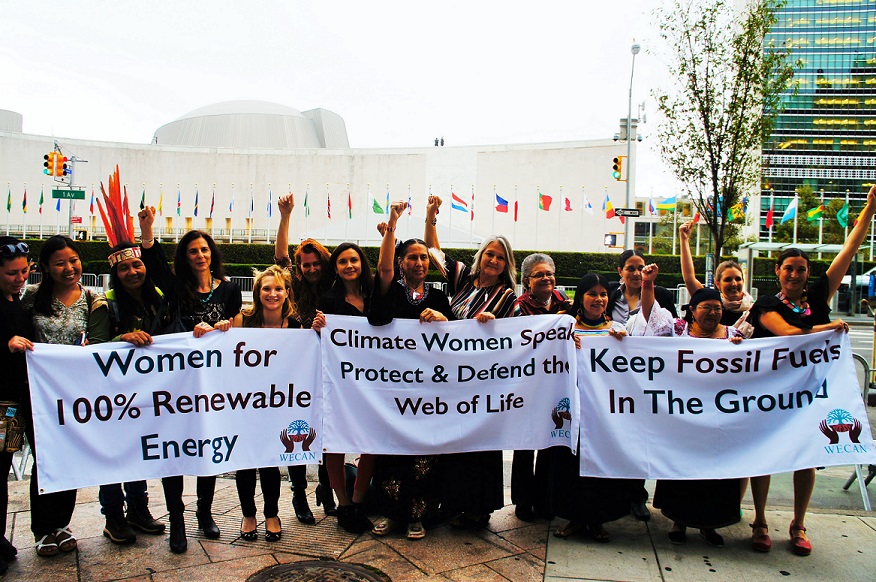
by DGR Colorado Plateau | Oct 11, 2015 | Climate Change, Lobbying, Protests & Symbolic Acts, Women & Radical Feminism
SAN FRANCISCO– On Tuesday, September 29th, 2015 women from fifty countries around the world took action for climate justice, gender equality, bold climate policies and transformative solutions as part of the Global Women’s Climate Justice Day of Action organized by the Women’s Earth and Climate Action Network (WECAN International).
From Sudan to the Philippines, from Ecuador to France, women raised their voices collectively to show resistance to social and environmental injustice and to present their solutions and demands for a healthy, livable planet.
In Port Harcourt, Nigeria women organized the ‘African Women Uniting for Energy, Food, & Climate Justice Exchange’, during which they shared struggles and solutions around oil extraction in the Niger delta and led a march through the city. In Swaziland, women united to sign the Women’s Climate Declaration and dialogue about why women experience disproportionate climate impacts and what can be done to address this injustice.
In Scotland, women collected trash from the beach and ocean to create an art installation highlighting the plight of threatened Arctic ecosystems. In Odisha, India, women united to speak out against deforestation fueled by the mining industry, taking direct action by planting trees and writing a memorandum to local government officials calling for communitywide reforestation programs led by women. Many worldwide participants voiced their demands for their governments to keep fossil fuels in the ground and immediately finance a just transition to 100% renewable energy.
Action recaps, photos, and statements from worldwide participants have been compiled on a central Day of Action gallery, from which they are being shared and amplified across the globe.
While women held decentralized actions in their communities, WECAN International convened a September 29th hub event, ‘Women Speak: Climate Justice on the Road to Paris & Beyond’ at the United Nations Church Center in New York City, directly across the street from where world leaders gathered for the annual United Nations General Assembly.
The event featured presentations and declarations of action by outstanding leaders including Indigenous activist and Greenpeace Canada campaigner Melina Laboucan-Massismo, May Boeve of 350.org, Jacqui Patterson of the NAACP, Patricia Gualinga, Kichwa leader of Sarayaku Ecuador, Thilmeeza Hussein of Voice of Women Maldives, and a special video message from Mary Robinson, former President of Ireland and President of the Mary Robinson Foundation-Climate Justice. The event concluded with a historic announcement and presentation of the ‘Indigenous Women of the North and South – Defend Mother Earth Treaty Compact 2015’.
As the day drew to a close, WECAN International and allies united for a direct action outside of the United Nations Headquarters.
“Women around the world are well aware that what is happening in the ‘halls of power’ is not nearly enough given the degree of climate crisis that we face and the injustices and impacts felt by women on the frontlines across the globe,” explained Osprey Orielle Lake, Founder and Executive Director of the Women’s Earth and Climate Action Network, “On September 29th, women across the world mobilized for bold, transformative climate change solutions and demonstrated the strength, diversity, and vitality of the women’s movement for climate justice. Women have always been on the frontlines of climate change, and now we are taking action to make sure that our voices and decision-making power are at the forefront as well. The stories, struggles, and solutions shared as part of the Global Women’s Climate Justice Day of Action will be carried forward to COP21 in Paris and beyond.”
***
The Women’s Earth and Climate Action Network (WECAN International) is a solutions-based, multi-faceted effort established to engage women worldwide as powerful stakeholders in climate change, climate justice, and sustainability solutions. Recent work includes the 2013 International Women’s Earth and Climate Summit, Women’s Climate Declaration, and WECAN Women’s Climate Action Agenda. International climate advocacy is complemented with on-the-ground programs such as the Women’s for Forests and Fossil Fuel/Mining/Mega Dam Resistance, US Women’s Climate Justice Initiative, and Regional Climate Solutions Trainings in the Middle East North Africa region, Latin America, and Democratic Republic of Congo. WECAN International was founded in 2013 as a project of the 501(c)3Women’s Earth and Climate Caucus (WECC) organization and its partner eraGlobal Alliance.
www.wecaninternational.org
@WECAN_INTL

by DGR Colorado Plateau | Aug 29, 2015 | Indigenous Autonomy, Mining & Drilling, Protests & Symbolic Acts
August 29, 2015
This morning, activists marched across The Bridge of the Gods to protest a proposed Nestlé bottled-water plant at Cascade Locks, Oregon.
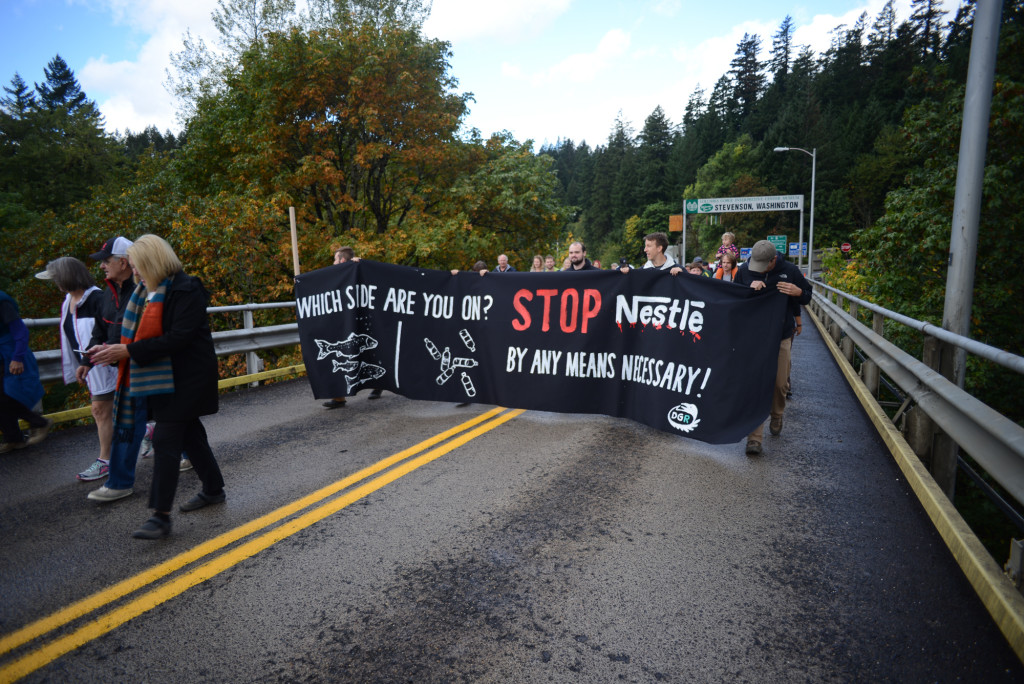
The bridge is only opened once a year for pedestrian traffic. Hundreds of sightseers and community members gather for the stunning view of the Columbia River. Today, they were joined by twenty protesters, who marched with a bridge-spanning banner that read: “Stop Nestlé By Any Means Necessary.”
Nestlé is the world’s largest food and beverage firm. Despite a history of human rights abuses, this Switzerland-based corporation has made billions privatizing public water supplies around the world.
Their planned bottling facility in the Columbia River Gorge would siphon off 118 million gallons of water every year from Oxbow Springs. Opposition is widespread, especially from indigenous communities.
“Nestlé already has millions, they don’t need our water,” said Ernest J. Edwards of the Yakama Nation. “Our water is for the salmon.”
Treaties made with the Confederated Tribes of Warm Springs recognize their fishing rights. Tribal member Anna Mae Leonard held a five-day hunger strike last week, surviving only on water from Oxbow Springs. Despite this community opposition, the State of Oregon and local governments have so far sided with Nestlé.
“The water of the Gorge does not belong to Nestlé. It belongs to the Salmon, to the forests, to all non-humans, and to the indigenous communities,” said protester Jules Freeman. “It’s a desecration to bottle this water in toxic plastic and sell it back to us for a profit.” Freeman is a member of Deep Green Resistance, the group that organized the protest.
Opposition to Nestlé bottled water plants has been successful in the past; projects in Florida, Wisconsin, California, and elsewhere were scrapped after communities rose up in defiance. Freeman thinks the same can be done here.
“The community does not want this, but the government has not listened. But it doesn’t matter: if they won’t stop Nestlé, we will.”
If you are concerned about the Nestlé project, contact Oregon Governor Kate Brown at 503-378-4582 and Oregon Department of Fish and Wildlife Director Curt Melcher at 503-947-6044.

by DGR News Service | Oct 7, 2014 | Biodiversity & Habitat Destruction, Colonialism & Conquest, Protests & Symbolic Acts, Toxification
By Sacred Mauna Kea
Mauna Kea Protest
Tuesday, October 7, 2014 — 7am to 2pm,
Saddle Road at the entrance to the Mauna Kea Observatory Road
Native Hawaiians and non-Hawaiians will gather for a peaceful protest against the Astronomy industry and the “State of Hawaii’s” ground- breaking ceremony for a thirty-meter telescope (TMT) on the summit of Mauna Kea.
Native Hawaiians and non-Hawaiians will gather for a peaceful protest
against the Astronomy industry and the “State of Hawaii’s” ground-
breaking ceremony for a thirty-meter telescope (TMT) on the summit of
Mauna Kea.
CULTURAL ISSUES: Mauna Kea is sacred to the Hawaiian people, who
maintain a deep connection and spiritual tradition there that goes
back millennia.
“The TMT is an atrocity the size of Aloha Stadium,” said Kamahana
Kealoha, a Hawaiian cultural practitioner. “It’s 19 stories tall,
which is like building a sky-scraper on top of the mountain, a place
that is being violated in many ways culturally, environmentally and
spiritually.” Speaking as an organizer of those gathering to protest,
Kealoha said, “We are in solidarity with individuals fighting against
this project in U.S. courts, and those taking our struggle for
de-occupation to the international courts. Others of us must protest
this ground-breaking ceremony and intervene in hopes of stopping a
desecration.”
Clarence “Ku” Ching, longtime activist, cultural practitioner, and a
member of the Mauna Kea Hui, a group of Hawaiians bringing legal
challenges to the TMT project in state court, said, “We will be
gathering at Pu’u Huluhulu, at the bottom of the Mauna Kea Access
Road, and we will be doing prayers and ceremony for the mountain.”
When asked if he will participate in protests, he said, “We’re on the
same side as those who will protest, but my commitment to Mauna Kea is
in this way. We are a diverse people…everyone has to do what they know
is pono.”
ENVIRONMENTAL ISSUES: The principle fresh water aquifer for Hawaii
Island is on Mauna Kea, yet there have been mercury spills on the
summit; toxins such as Ethylene Glycol and Diesel are used there;
chemicals used to clean telescope mirrors drain into the septic
system, along with half a million gallons a year of human sewage that
goes into septic tanks, cesspools and leach fields.
“All of this poisonous activity at the source of our fresh water
aquifer is unconscionable, and it threatens the life of the island,”
said Kealoha. “But that’s only part of the story of this mountain’s
environmental fragility. It’s also home to endangered species, such as
the palila bird, which is endangered in part because of the damage to
its critical habitat, which includes the mamane tree.”
LEGAL ISSUES: Mauna Kea is designated as part of the Crown and
Government lands of the Hawaiian Kingdom.
Professor Williamson PC Chang, from the University of Hawaii’s
Richardson School of Law, said, “The United States bases its claim to
the Crown and Government land of the Hawaiian Kingdom on the 1898
Joint Resolution of Congress, but that resolution has no power to
convey the lands of Hawaii to the U.S. It’s as if I wrote a deed
saying you give your house to me and I accepted it. Nobody gave the
land to the U.S., they just seized it.”
“Show us the title,” said Kealoha. “If the so-called ‘Treaty of
Annexation’ exists, that would be proof that Hawaiian Kingdom citizens
gave up sovereignty and agreed to be part of the United States 121
years ago. But we know that no such document exists. The so-called
‘state’ does not have jurisdiction over Mauna Kea or any other land in
Hawaii that it illegally leases out to multi-national interests.”
“I agree with how George Helm felt about Kahoolawe,” said Kealoha. “He
wrote in his journal: ‘My veins are carrying the blood of a people who
understood the sacredness of land and water. Their culture is my
culture. No matter how remote the past is it does not make my culture
extinct. Now I cannot continue to see the arrogance of the white man
who maintains his science and rationality at the expense of my
cultural instincts. They will not prostitute my soul.’”
“We are calling on everyone, Hawaiians and non-Hawaiians alike, to
stand with us, to protect Mauna Kea the way George and others
protected Kahoolawe. I ask myself every day, what would George Helm
do? Because we need to find the courage he had and stop the
destruction of Mauna Kea.”
From Sacred Mauna Kea: http://sacredmaunakea.wordpress.com/
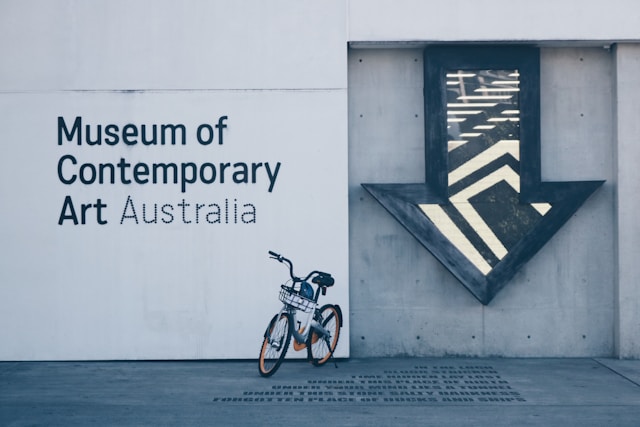
by DGR News Service | Mar 17, 2014 | NEWS, Protests & Symbolic Acts
By Natalie Bochenski / Sydney Morning Herald
An anti-fracking activist group will “poison” a major work at the Gallery of Modern Art to protest its sponsorship by Santos.
Generation Alpha said Heritage, which features 99 animals gathered around a blue water pond, showed exactly the kind of environment that the natural resources company would ruin.
Spokesman Ben Pennings said it was “beyond ironic” that Santos would sponsor the Falling Back to Earth exhibit.
“Fracking involves dozens of poisonous chemicals that threaten water tables and water-poisoning accidents are a regular part of Santos’ business,” he said.
A Santos GLNG spokesman said Generation Alpha’s claims were incorrect.
“Natural gas from coal seams has been produced safely and sustainably in Queensland for 20 years. Santos GLNG’s activities comply with Queensland legislation, which is some of the toughest in the world, with six pieces of legislation and four government agencies regulating water issues alone,” he said.
Generation Alpha has called on GOMA to cancel the Santos GLNG Family Fun Day this weekend and withdraw from the sponsorship arrangement altogether.
“We will target them ’til they do,” Mr Pennings said.
Hundreds of people are expected to attend the Family Fun Day, which will feature guided tours of the exhibit, lectures, face-painting and other activities.
“We have inside information about how we can symbolically ‘poison’ the water while not damaging the artwork,” Mr Pennings said.
“On top of that, it will look great. The crowds will love it!”
He said Generation Alpha, which has 43,000 fans on Facebook, wrote to Cai Guo-Qiang one month ago describing the sponsorship deal as unethical, and at odds with the message of Cai’s work that the environment be respected.
The Queensland Art Gallery/Gallery of Modern Art issued a statement saying it supported the right for groups like Generation Alpha to peacefully protest in a way that doesn’t interfere with visitors’ experience or artwork safety.
However, QAGOMA has no intention of ending its sponsorship agreement with Santos.
“Santos’ five year partnership with the Gallery is the most significant single corporate investment in the Gallery’s history, and has supported our summer exhibition series and our Children’s Art Centre,” the statement read.
A Santos spokesman said Santos operated its business “safely and responsibility” in accordance with Queensland’s regulatory framework.
“As an Australian company that has been part of the Queensland community for over 50 years, we are pleased to share the benefits of a world-class gas industry with the community through contributions including our five-year support of QAGOMA,” he said.
From Sydney Morning Herald: http://www.smh.com.au/entertainment/art-and-design/activists-threaten-to-poison-major-artwork-20140312-34ml2.html
Photo by Choi Hochit on Unsplash

by Deep Green Resistance News Service | Nov 23, 2013 | Direct Action, Protests & Symbolic Acts, Strategy & Analysis
By Ben Pennings / Over Our Dead Bodies
Big Coal? We’re talking the biggest. The Galilee Basin is the biggest proposed coal complex in the world. The numbers are staggering, frightening; well past the point of insanity.
The great news is that the nine mines planned are very marginal economically. The ‘quality’ of coal is low, the price of coal is low, and the debt levels of many companies involved are high. However, a company called Aurizon is planning to bail out the debt-ridden company GVK, allowing them to dig up the first 2 mines. These mines alone would be responsible for carbon pollution 6 times that of the UK.
A broad cross-section of the mainstream environment movement have signalled their intentions towards Aurizon, but thus far been pretty much ignored. Millions of emails have gone unheard. Aurizon continues unabated towards investing billions to mine the Galilee Basin, before solar makes it completely economically unviable.
The Over Our Dead Bodies campaign is adding a new dimension to the decision-making processes of Aurizon, and has garnered significant interest from both the company and police. Aurizon now face sustained direct action and civil disobedience strategies, on top of the increasing pressure from mainstream groups. The campaign is blatantly honest, starting to document the number of activists in Australia and globally who will do whatever it takes to stop Aurizon.
Activists started the campaign by stealing a ‘carbon bomb’ from their offices, visiting the CEO’s mansion (twice) and messing with their football sponsorship. All in one weekend. While also hunger striking! But the real deal is still to come.
How can activists be honest with Aurizon about what may be on the way? Go along to their AGM of course! I was one of twelve activists who bought enough shares to attend and ask questions that were not the usual fare. For the first time in AGM history (as far as we know), activists asked audacious questions to directly challenge a company about the security, insurance, industrial action and recruitment costs related to direct action by environmental activists – providing an honest warning to shareholders of risks the company has thus far refused to disclose.
A multi-organisation protest was also held outside the AGM venue. Police inside and outside the AGM outnumbered protesters two to one – uniformed, plain clothes, photographers and high-ranking officers. Walking from our briefing to the venue, the anti-terrorism police made their presence known, greeting me by name. As did other officers throughout the morning. Nice to be loved! The leading image above shows one of the anti-terrorism police ‘Aaron’ (real name is Bruce) talking to an activist on the day.
Activists know they can’t stop Aurizon’s plans through appealing to their ethics or values. Those who have tried have failed. The chair of the board John Prescott confirmed this belief when answering the first question:
“The fundamental business of this company is transportation, the majority of it by heavy haul rail systems, and a key part of that is certainly the carriage of coal… it is a fundamental part of this company’s business to carry coal for interested customers. It is a perfectly legitimate activity and it is one that to withdraw from would not be in the interest of shareholders, customers, employees, and the communities in which we serve.”
He also admitted to shareholders in this first exchange that Aurizon “have not made any estimates” when asked about the costs of activism by organisations with many millions of members. This is an important admission but the point needed to be laboured. The next question about their security strategies got right to it:
“It seems to me that Aurizon are very vulnerable to direct action strategies from environmentalist groups. Given you have thousands of kilometres of rail line and have difficult to secure facilities around the country, what strategies do you have in mind to secure what seems to be in-securable?”
After questions about climate change, water and the future of coal, it got serious with a question about targeting the board and executives:
“As Aurizon’s planned investment in the coal mines in the Galilee Basin (involves releasing) truly massive amounts of carbon into the atmosphere, threatening life as we know it on this planet, such a radical step calls for a radical response. Are you aware that over two hundred activists from one group alone have thus far committed to use direct action against the Aurizon Board of Executives to remind them of their personal responsibility regarding runaway climate change; and given they claim to have home addresses of most of the board members and senior executives, and considering activists have already visited the CEO’s home twice, are you concerned that executives and board members will leave the company if they are seriously challenged in their homes and neighbourhoods about these responsibilities, their responsibilities beyond Aurizon, responsibilities to the future of all of our children, our grandchildren, the community, country and the world we live in?”
Despite protestations, a further audacious question was asked, this time about stopping trains with cardboard boxes:
“In 2011, an activist stopped a coal train in New South Wales using a lightweight box contraption. Now he was inside that box, but it’s easily conceivable that you could stop a coal train with an empty cardboard box. Now given you’ve got thousands of kilometres of track, how do you envisage oversight over those tracks and managing that; I can see it would be quite easy for activists to stop coal trains and get away with it scot free. So is there a cost each time a train is stopped like this, and have you factored those kinds of costs into your business plans?”
Just by chance, this happened to be outside the building when shareholders left the meeting. 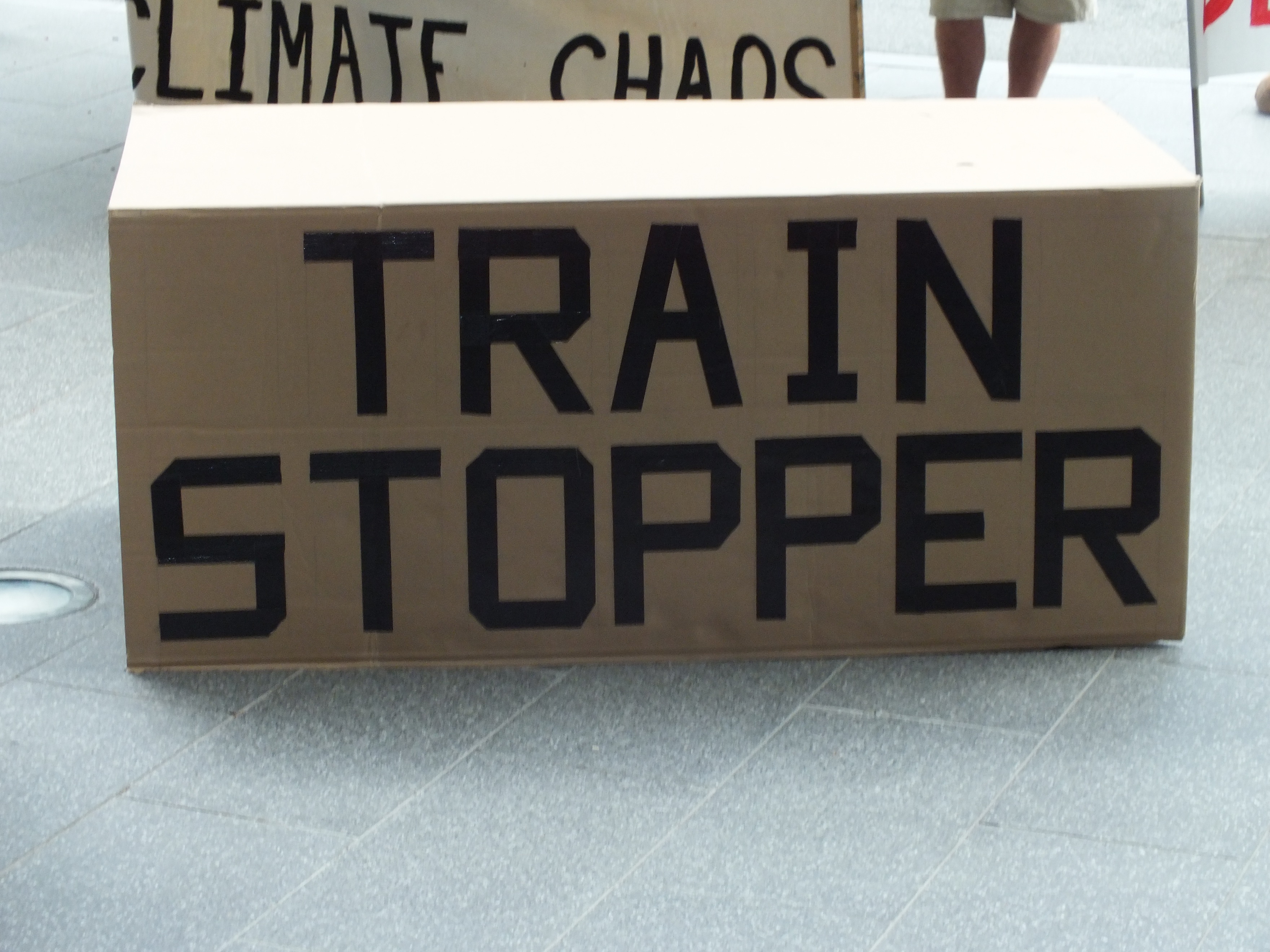
You can imagine the company (and some shareholders) were not too happy with such questions. The chair of the board said repeatedly that they would not divulge security strategies, but it seemed reasonably clear such strategies did not exist. But the shareholders did respond with applause to the question about coal dust, public health, and the excessive salary of the CEO:
“My question is to Lance Hockridge, CEO, and my concern is about dust. I’ve been reading a bit in the media the last few months about coal dust coming from wagons and about the particles, and the doctors and health experts’ concerns about the dust particles; the larger ones and the smaller ones which can get lodged in the lungs and in the bloodstream and the concern, particularly for children… My question, given that Aurizon has so far refused to cover the coal wagons and that there is quite a bit of public outcry about this issue is, Lance, you earned $6 million more than the average Australian last financial year, would you personally be willing to donate some money to stop the damage to public health, and if not, would you personally live on a railway line and breathe in what you transport?”
That question was bound to be popular but this question hit a different nerve:
“Are you concerned that once environmental activists start direct action strategies that your unionised staff will undertake industrial action due to perceived safety risks? Have you factored in these potential massive costs to your investment in the Galilee?”
A shareholder responded to this, saying she was “absolutely appalled at the suggestion that lives would be put at risk because of ideological beliefs.” I jumped up to defend this activist before question time ended. It is Aurizon in fact who are putting millions of lives at risk over an ideological belief, the belief that profit by any legal means trumps ethical considerations, or a livable planet for that matter. After the AGM some shareholders spoke freely with activists. Many were concerned about climate change, coal dust, and the shortening future of the coal industry. Aurizon have since sent a strongly worded legal letter, threatening a Supreme Court injunction against Generation Alpha, Over Our Dead Bodies and their ‘members’. What a shame that Generation Alpha is a Facebook page, Over Our Dead Bodies is a website, and neither have members! Aurizon write that they are ‘disappointed’ in us, and if we do what they say we’ve threatened, we’re in big trouble! But now they just have to wait and prepare, knowing they can do little to stop the next move by the 221 (and counting) activists who have said “Over Our Dead Bodies”.









